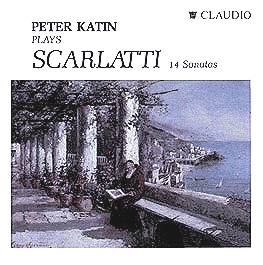SCARLATTI
14 Sonatas
 Peter Katin (piano)
Peter Katin (piano)
 Claudio Records CR
35102-D
Claudio Records CR
35102-D
Crotchet
AmazonUK
AmazonUS

I have had something of a love/hate relationship with Scarlatti and his sonatas.
People may say, 'What's in a name?' Indeed. But sonata seems a misnomer to
me for these single movement pieces. Are they miniatures or are they substantial
pieces worthy of such a distinguished descriptive title?
In the original Italian manuscripts the sonatas are described as exercises
and, often, that is all that they are - merely educational pieces. Quite
frankly, some of them are tedious and are best avoided.
They have no tempo indications or indications as to tone. The pianist has
to be a detective.
The sonatas need levels of sound. For example, one would not expect crescendos
or diminuendos as these could not be achieved on the keyboard instruments
for which they were written. But some pianists do this. Peter Katin, being
more intelligent, does not.
Perhaps we should simply look at them as music.
It is known that I admire the playing of Peter Katin but I am both an honest
reviewer and music lover. My strong views are borne of detailed study over
forty years and of my love for music.
Peter Katin began his career by playing all the big, romantic and fearfully
difficult concertos. His 1953 Prom with Rachmaninov's Third was a sensation.
He has played all five of Rachmaninov's concert works but it is a pity that
concertos three and four and the Paganini rhapsody he has never recorded.
I remember hearing his Paganini Rhapsody and wish I had recorded it. It was
sublime and although the piece is rather hackneyed now I still love it. I
saw Peter perform the Fourth Concerto at Portsmouth with George Hurst and,
call me perverse if you wish, I believe this is Rachmaninov's most original
and finest work along with the glorious Symphonic Dances.
He has also dazzled us with Tchaikovsky One, a brute of a piece to play,
but in recent years he has shown us definitive versions of Mozart and Beethoven.
His Brahms' of the 1970s was truly magnificent.
What is it about his playing that marks him out for me?
I will let you into a secret.
Peter is a very slow learner. He agonises over everything. He will not play
anything unless he is totally happy with his performance although Prokofiev
Three was an exception.
For further details see my interview with Peter available on this very website
which is a hive of information.
Now for the Scarlatti. The D major K96 is noted for the clarity of repeated
notes, excellent balance between hands and the ornamentation is so good that
it naturally blends with the music. Few do this as well as Katin. The style
and vigour are highly commendable. The other D major is K490 which highlights
my reservations about this composer. It would be unfair to say it is all
scales but it almost is and this is what makes it tedious. Peter tries to
salvage the music by well-judged contrasts of tone. He plays all the repeats
in the sonatas and this tends to give them that slightly hypnotic effect.
The D minor K517 has the reliable fingerwork of this most exciting of pianists
and the tempo is spot on. The A major K208 is a non-starter for me, plaintive,
or do I mean plain, but, again the ornamentation is first class. The A minor
K3 is a lively and rewarding piece. Again it reeks of academic devices, this
time arpeggios but the deft stylish playing and the wittiness is only to
be admired. The F minor K 238 is serious almost tragic with some splendid
nuances from the pianist but the piece is nothing to write home about. The
second F minor K239 proves all my points about this pianist: the wonderful
clarity of each line and, where necessary, the sense of attack. It is this
playing that is of benefit to all students and will be appreciated by them
and by music lovers who want the very best. I do not care for the B flat
sonata K193. It is pointless music with scales and trills; not a sonata but
an exercise.
Of some significance is the C minor K84 which is a grade eight piece for
Associated Board exams for the next two years. Peter realises it splendidly.
The work is almost romantic and his occasional rubato is very touching. The
two sonatas in G, K571 and K339 respectively are tame. The two C major sonatas,
K358 and K159 have their moments, particularly K159, but Peter saves
the K420 to last. This is very entertaining, foot-tapping stuff.
The sound is fine. The recording was made 15 years ago and has been 'in the
can' for that length of time.
The performances are so good that anything I say will be unnecessary and
foolish.
David Wright

